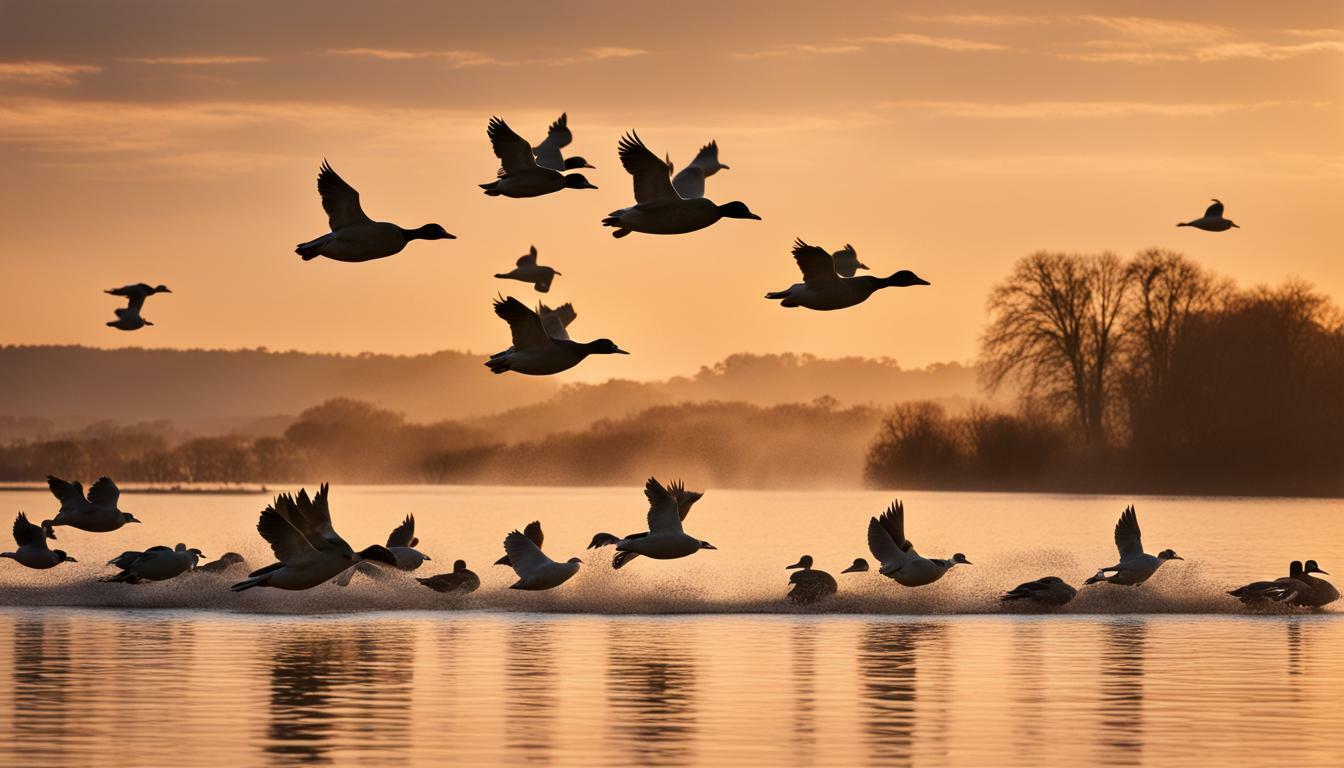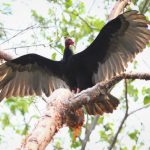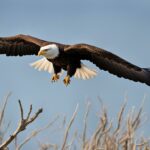If you’re considering adopting a pet duck, you may be wondering about their flight capabilities and whether or not they’re prone to flying away. Ducks are indeed capable of flying, although some breeds are more inclined to flying than others. Understanding their natural instincts and taking steps to manage their flight behavior can help prevent them from flying away and ensure their safety.
Key Takeaways:
- While ducks are capable of flying, not all breeds are prone to flying.
- Understanding their natural instincts and environmental factors can help prevent them from flying away.
- Training and bonding with your pet duck can also help manage their flight behavior.
- Creating a secure enclosure and implementing measures to prevent accidental escapes is crucial for their safety.
Understanding the Flying Behavior of Pet Ducks
As a pet owner, it’s important to understand the natural instincts and behavior of your pet ducks, especially when it comes to their flight capabilities. While ducks are not typically considered flying birds, they do have the ability to fly short distances, particularly during migration.
Ducks have adapted to their natural habitats over thousands of years, developing specific physical features and behaviors that allow them to fly, swim, and forage for food. As pets, however, ducks do not have access to their natural environment, and their flight behavior can be altered due to their domestication.
Contrary to popular belief, not all breeds of ducks have the same flying capabilities. Domesticated ducks are bred for various purposes, such as meat, eggs, or ornamental characteristics, and as a result, some breeds have been selectively bred to have limited flight capabilities.
Breeds such as Pekin and Muscovy ducks, for example, are heavier and have shorter wings, making it more difficult for them to fly. Other breeds, such as Mallard ducks, are more aerodynamic and have longer wings, allowing them to fly short distances. Understanding your duck’s breed is crucial when it comes to managing their flight behavior.
Age also plays a role in a duck’s flight capabilities. Young ducks are usually more energetic and adventurous, and may be more inclined to fly away from their home. Adult ducks, on the other hand, may be less likely to fly away, but may still be susceptible to wanderlust during mating season or if they feel threatened.
Additionally, socialization can also impact a duck’s flight behavior. Pet ducks that are raised with other ducks or animals may be less likely to fly away, as they feel more comfortable and secure in their environment. However, ducks that are raised in isolation may be more prone to wanderlust or disorientation, which can lead to accidental escapes.
Factors Influencing Pet Ducks’ Flight Instincts
As much as you may enjoy watching your pet ducks fly, you may be concerned about the possibility of them flying away. While some ducks may never take flight, others may be more inclined to do so due to various factors.
Breed is one of the main factors influencing a duck’s inclination to fly. Some breeds, like the Mallard, are known for their strong flying abilities, while others, like the Pekin, are heavier and less likely to fly. It’s important to research the breed of your pet duck to understand their natural flight instincts.
Age can also play a role in a duck’s willingness to fly. Younger ducks may be more adventurous and prone to flying, while older ducks may have less interest or energy for flight. Socialization also plays a part, as ducks that are raised with other ducks and in a suitable environment are more likely to stay grounded.
Other factors that may influence a duck’s flight instincts include their physical health, the availability of food and water, and the presence of predators or other potential threats. By carefully managing these factors and taking appropriate precautions, you can help prevent your pet ducks from flying away.
Training Pet Ducks Not to Fly
If you’re worried about your pet ducks flying away, it’s essential to train them to stay grounded. With patience, consistent practice, and positive reinforcement, you can teach your ducks to remain within your property’s confines.
Here are some training tips to help your ducks learn not to fly:
- Start training your ducks when they’re young. It’s easier to train them before they learn to fly.
- Use a combination of positive reinforcement and bonding techniques to encourage your ducks to stay close to you.
- Use treats to reward your ducks when they stay close to you or come when you call them.
- Teach your ducks basic commands, such as “stay” and “come.” This will help you control their movements and keep them from flying away.
Wing-clipping and flight feather maintenance:
If training alone isn’t sufficient, you can use wing-clipping or maintain your ducks’ flight feathers to keep them grounded. Wing clipping involves cutting the primary flight feathers on one or both wings to prevent a bird from flying. You can also maintain the flight feathers by trimming them periodically to keep your ducks’ flying ability in check.
Remember, wing-clipping and feather maintenance should be done correctly and with care. Always seek advice from a veterinarian or experienced duck owner before attempting to clip your ducks’ wings or trim their feathers.
Keeping Pet Ducks Safe at Home
As a pet duck owner, it’s important to ensure that your feathered friends are safe and secure in your home environment. While ducks can be trained not to fly away, accidents can happen, and it’s best to have measures in place to prevent any potential escapes.
The first step in keeping your pet ducks safe is to create a secure enclosure that is predator-proof and duck-friendly. The enclosure should be large enough for the ducks to roam around and have access to water, food, and shelter. Make sure the enclosure has a fence that is at least 3 feet high, and for added security, bury chicken wire below the surface to prevent predators from digging in.
Another important aspect of keeping pet ducks safe is to supervise them at all times when they are outside of their enclosure. Ducks are curious animals that love to explore their surroundings, so it’s crucial to ensure you are always keeping an eye on them to prevent any accidents or escapes.
If you have a pond or other bodies of water on your property, be sure to surround it with a fence or barrier to prevent accidental drowning. Ducks love to swim, but they need to be supervised when they are near water to ensure their safety.
In addition to these measures, it’s important to ensure that your ducks have access to adequate food, water, and shade. Ensure that their food and water is always clean and fresh, and that they have access to a shady area during hot weather. This is especially important as ducks can suffer from heatstroke.
By following these tips, you can create a safe and secure environment for your pet ducks at home.
Managing Pet Ducks’ Flight Capability
As a pet duck owner, managing their flight capability is essential for their safety and your peace of mind. Here are some strategies to help you manage your pet ducks’ flight capability:
Wing-clipping
Wing-clipping is a common practice used by pet duck owners to prevent them from flying long distances or reaching high altitudes. This process involves the removal of some of the primary feathers on one or both wings, which reduces their lift and makes it harder for them to take off or fly away.
It is important to note that wing-clipping should only be done by a veterinarian or someone with experience to avoid causing harm to your pet duck. Wing-clipping may need to be repeated periodically as feathers grow back.
Flight Feather Maintenance
Another option for managing your pet ducks’ flight capability is to maintain their flight feathers. Cutting or removing just the tips of the primary feathers can reduce their lift and prevent them from flying away. However, it is important to not trim them too much, as this can cause discomfort or hinder their ability to fly if they need to escape danger.
Training and Bonding
Training and bonding with your pet duck can also help manage their flight capability. Create positive experiences for your duck that make them want to stay close to you, such as offering treats or engaging in activities they enjoy. By creating a strong bond, your pet duck will be less inclined to fly away from you.
Additionally, training your pet duck to come when called or follow you on a leash can help prevent escape. Remember to use positive reinforcement and never punish your pet duck for flying away or misbehaving.
Creating a Safe Environment
Preventing your pet duck from flying away starts with creating a safe and secure environment for them to live in. Ensure that their enclosure is properly secured with fencing or netting to prevent them from flying away or predators from getting in. Regularly inspect and maintain the enclosure to ensure there are no gaps or holes that could allow for escape.
Providing plenty of enrichment and space for your pet duck can also help reduce their desire to fly away and explore. This can include providing toys, access to water for swimming, and natural areas to forage in.
In conclusion, managing your pet duck’s flight capability is essential for their safety and well-being. Use a combination of strategies such as wing-clipping, flight feather maintenance, training and positive bonding, and creating a safe environment to prevent accidents and ensure your pet duck stays close by.
Building a Secure Enclosure for Pet Ducks
As a responsible pet owner, you undoubtedly want to ensure that your pet duck remains safe and secure within your property. Building a secure enclosure for your pet ducks is an essential step in preventing them from flying away and protecting them from predators.
The first step in building a secure enclosure is selecting a suitable location. Choose a flat and well-drained area that is free from potential risks such as poisonous plants or areas that are prone to flooding. Ensure that the enclosure is large enough to allow your ducks ample space to move around and explore.
Once you have selected the location, you can begin constructing the enclosure. Use materials such as wooden posts, chicken wire, and mesh netting to form a sturdy and secure fence around the perimeter of the enclosure. Ensure that the fence is at least six feet high to prevent your ducks from flying over it.
It is essential to provide a shelter within the enclosure where your ducks can rest and feel safe. You can build a simple wooden shelter or use a pre-made shelter that is large enough to accommodate your ducks comfortably. Ensure that the shelter is well-ventilated, with a raised floor to keep your ducks warm and dry.
Next, consider the flooring of the enclosure. The ideal flooring should be easy to clean and maintain and provide good drainage. You can use a layer of wood shavings or straw over a well-draining soil substrate or opt for a concrete floor that can be hosed down regularly.
Finally, add some enrichments to the enclosure to keep your ducks entertained and active. Items such as small pools, perches, and hiding places can provide your ducks with stimulation and exercise while keeping them safe and secure.
By building a secure enclosure for your pet ducks, you can ensure that they are safe and happy within your property. With the right materials, location, and design, you can prevent your ducks from flying away and protect them from potential risks and predators.
Duck Flight Training Tips and Flight Control Techniques
If you want your pet duck to stay safe and grounded, it’s essential to train and manage their flight behavior. Here are some duck flight training tips and flight control techniques to help you keep your feathered friend close by:
1. Start early
Begin training your pet duck not to fly while they’re still young and haven’t yet developed their flight feathers. This will make it easier to teach them good ground habits and prevent them from becoming too attached to their ability to fly away.
2. Use positive reinforcement
Positive reinforcement is a proven training technique that encourages good behavior through rewards. When training your pet duck not to fly, use positive reinforcement by rewarding them with treats or praise when they stay on the ground.
3. Build a bond
Pet ducks are more likely to stay close to their owners if they feel loved and bonded. Spend time with your duck, feed them by hand, and communicate with them gently to build a strong bond that will encourage them to stay close by.
4. Wing-clipping
Wing-clipping is a humane practice that involves trimming some of your pet duck’s flight feathers to prevent them from becoming airborne. Do not clip more than the first ten primary feathers on each wing. This will not harm your pet and will prevent them from flying away.
5. Create a secure environment
Building a secure enclosure for your pet duck is one of the best ways to keep them safe and prevent them from flying away. Ensure that the enclosure is large enough for your pet to move around comfortably and that it has a covered area to keep them warm and dry.
6. Use flight control devices
You can use various flight control devices to restrict your pet duck’s flight, such as flight suits or harnesses. These devices prevent the duck from achieving full flight and give you control over their movements.
7. Practice regularly
Consistency is key when training your pet duck not to fly. Practice regularly, and be patient; it can take some time for your pet duck to develop good ground habits and remain grounded.
By following these duck flight training tips and flight control techniques, you can effectively manage your pet duck’s flight capabilities and keep them safe and happy at home.
Conclusion
It’s essential to understand the flight instincts and abilities of pet ducks to prevent them from flying away. Factors such as breed, age, and socialization can influence their inclination to take flight. By creating a safe and secure environment, implementing training techniques, and managing their flight capabilities, owners can keep their pet ducks protected and happy.
Remember, building a secure enclosure and training your pet ducks not to fly are crucial steps to ensure their safety. It’s essential to provide them with sufficient space to exercise, socialize, and fulfill their natural instincts. By applying the tips and guidelines discussed in this article, you can keep your pet ducks safe and happy.
FAQ
Q: Can pet ducks fly away?
A: Yes, pet ducks have the ability to fly away if given the opportunity. However, there are measures you can take to prevent this.
Q: What factors influence pet ducks’ flight instincts?
A: Breed, age, and socialization are some factors that can influence a pet duck’s inclination to fly. Certain breeds may be more prone to flying, while younger ducks are typically more active and likely to attempt flight.
Q: How can I train my pet duck not to fly?
A: Training your pet duck to stay grounded can be achieved through positive reinforcement techniques. Consistent training, bonding, and creating a secure environment are key elements in preventing your pet duck from flying away.
Q: How can I keep my pet ducks safe at home?
A: It is important to create a secure environment for your pet ducks to prevent accidental escapes. This can include constructing a suitable enclosure, implementing fencing measures, and ensuring there are no gaps or openings where ducks could slip through.
Q: What are some strategies for managing pet ducks’ flight capabilities?
A: Strategies such as wing-clipping and regular flight feather maintenance can help manage your pet duck’s ability to fly. However, it is important to consult with a veterinarian or avian specialist before attempting these procedures.
Q: How can I build a secure enclosure for my pet ducks?
A: Building a secure enclosure for your pet ducks involves using sturdy fencing materials, ensuring the fencing is buried to prevent digging, and providing adequate shelter and access to water. It is also important to regularly inspect the enclosure for any potential weaknesses.
Q: Are there any additional tips for training and controlling the flight behavior of pet ducks?
A: Additional tips include using positive reinforcement, establishing a bond with your pet duck through regular interaction, and providing mental and physical stimulation to reduce the desire to fly. Remember, patience and consistency are key in training your pet duck.











